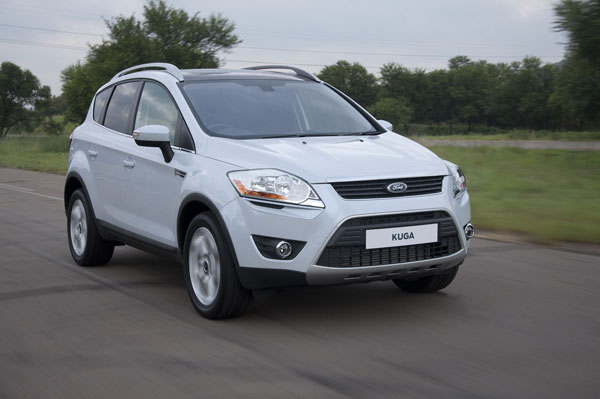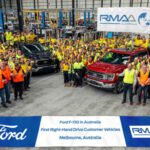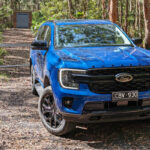
Like many SUVs these days Ford Kuga is aimed at those who have always loved Fords
and are keen to have the advantage of a taller vehicle that can carry relatively bulky loads.
And those who aren’t as young as they used to be will find it easier to get in and out of a
vehicle with seats at hip height, rather than knee high.
Many Kugas are two-wheel drive vehicles, others have all-wheel-drive and can be used to
explore interesting bush tracks and fire trails. Ground clearance is generally the limiting
factory, but driven sensibly by those who know what they’re doing can cover some
interesting terrain way from the madding crowd.
Ford Kuga had already been on sale in some countries for almost four years before it
reached us here. It was discontinued here in April 2013 and replaced by one that was
virtually all-new.
More interior space is a big feature of the second generation. Cleverly, the rear seats not
only have more legroom, their backs recline over a 10-degree range, allowing you to
juggle between luggage and passenger space. In any case, the cargo area is larger than
that in the 2012 model.
Ride comfort is pretty good and the Kuga has little trouble coping with most rough
backroads. However, the suspension travel isn’t always long enough to cope with really
bad surfaces and there can be some bottoming out.
Being Euro based vehicles handling is good in the original series Kuga and even better in
the second generation. Aussies who like to drive often chose Kuga over SUVs made by
Asian companies. Which may not be great if you’re buying one which has been thrashed
by previous owners…

Ford’s voice-activated Sync system allows hands-free operation. A major safety feature is
that Sync can operate an Emergency Assistance (EA) system that, when there is a
Bluetooth-paired smartphone, sends out an emergency call when either an airbag is
deployed and/or the car’s emergency fuel shut-off activated,
The first Kuga was only imported in its upmarket variants and powered by a 2.5-litre turbo-
petrol engine with 147 kW of power. It’s a bit of a gas guzzler, but great fun to sit behind.
A 1.6-litre EcoBoost four-cylinder turbo-petrol in two states of tune was offered. In January
2015 the 1.6 engines were replaced by a 1.5 or 2.0-litre units still with four cylinders.
The 2013 Kuga had a 2.0-litre turbo-diesel, it was replaced by a new-design diesel at the
end of 2014. These are more economical than the petrol engines, the older diesel aren’t
the most refined, the new one is a beauty.
There is a six-speed manual transmission in the lowest-cost Kuga models with front-drive
only. Others have a six-speed automatic.
Ford has been in Australia for almost 100 years and has dealerships all over the country,
even in very remote areas. Not all of the outlying ones will have spare parts for Kugas, but
can generally have them freighted in within a couple of business days.
Kuga is relatively easy to work on, but complex areas that should only be handled by
professionals. Keep clear of any items that affect safety.
Insurance costs are generally about average for this class. Shop around, but keep in mind
it’s better to build up a good history with one insurer than to save a few dollars by shifting
from year to year.
Ford Australia introduced a facelifted Kuga with added technology in mid-2017 but gave it
a new name, or rather an old name – it became the Ford Escape again. We won’t examine
this model in this used car review.
WHAT TO LOOK FOR
Look underneath for mud dirt and sand. Scratches on the doors may mean a Kuga has
been used on narrow bush tracks.
During your test drive listen for squeaks and rattles that may indicate the Kuga’s been
thumped over corrugated dirt roads like by an uncaring driver.
Check inside the cabin and cargo area for damage cause by poor luggage stowage and/or
misbehaving children.
Look over the paint as there were some defective vehicles in the earlier 2013 and 2014
models.
Check that the engine starts promptly and idles smoothly as soon as it kicks over.
If the engine idle hunts up and down when idling there may be troubles with the fuel
injection system.
Manual gearboxes should be smooth and quiet. Make sure the third-to second
gearchange quickly if it baulks or crunches there may be an expensive problem on the
way.
Automatic transmission should be fuss-free with changes that are all-but imperceptible.
PRICE GUIDE
Expect to pay from $6000 to $10,000 for a 2013 Ford Kuga FWD Ambiente; $8000 to
$12,000 for a 2014 AWD Ambiente or a 2016 FWD Ambiente; $10,000 to $16,000 for a
2013 AWD Titanium; $12,000 to $17,000 for a 2015 AWD Trend; $14,000 to $20,000 for a
2015 AWD Titanium; and $16,000 to $23,000 for a 2016 AWD Titanium.
CAR BUYING TIP
Take someone with you when checking out a used car – they can listen to the sales
people chatter on about how good the car is while you concentrate on checking the vehicle
for problems.
RECALLS: To browse recalls on all vehicles go to the ACCC at:
www.productsafety.gov.au/products/transport/cars/











